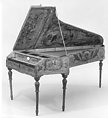Pianoforte
Not on view
The Stein family was a dynasty of keyboard makers originally from Augsburg and later Vienna. The first maker of the family was Johann Andreas Stein (1728–1792) who was credited with developing a new action, the prellmechanik, or the so-called "Viennese" action. Stein had several children that also built pianos, including his daughter Nannette and son Mattäus Stein. The brother and sister headed the Stein shop as their father's health failed, and after his death continued in this partnership. Nannette married Johann Andreas Streicher in 1794 and that same year the Stein shop was moved to Vienna. Nannette and Mattäus continued to build pianos together until 1802 when she and her husband started their own workshop using the Streicher name.
Technical description: Wing-shaped case on 4 detachable carved legs, wood; compass, 5 octaves, 2 semitones, with black naturals, white sharps; hammers divided at b-c1 by wood gap spacer over which runs a pair of unstruck strings that have their own damper; ebony natural heads have double score lines, tails are ebony or stained pear, accidentals of stained pear with bone tops; hammer shanks and escapement levers almost identical with those of Stein piano at Toledo Art Museum; keyboard of quarter-sawn spruce, having no buttons at balance point, but the keys are mortised for the pins; kapsels, shanks, escapement levers, damper jacks and blocks of pear; hammers of beech covered with 1 layer of leather (thick in bass, thin in treble); typical Stein box guide at rear of keys; soundboard of quarter-sawn spruce with bridge and nut of maple or beech painted black; top of pinblock veneered to match soundboard, but with grain running from bass to treble.
Due to rights restrictions, this image cannot be enlarged, viewed at full screen, or downloaded.
This artwork is meant to be viewed from right to left. Scroll left to view more.



